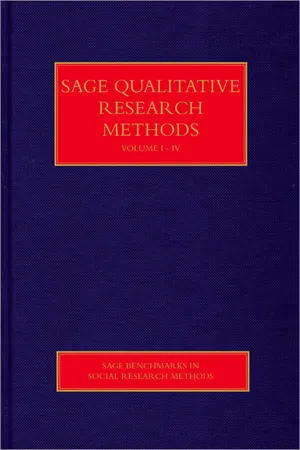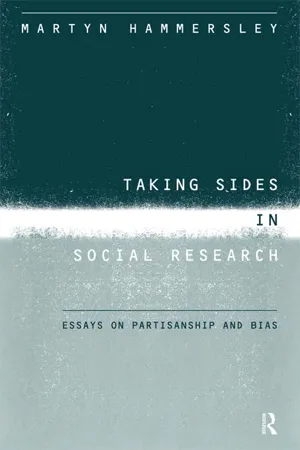Social Sciences
Howard Becker
Howard Becker is a prominent figure in sociology, known for his work on labeling theory and the sociology of deviance. He emphasized the importance of understanding how social groups create and apply labels to certain behaviors, influencing individuals' self-concept and behavior. Becker's research has had a significant impact on the study of social interaction and the construction of social reality.
Written by Perlego with AI-assistance
Related key terms
1 of 5
5 Key excerpts on "Howard Becker"
- Bruce Cohen, Bruce M.Z. Cohen, Bruce Cohen, Bruce M.Z. Cohen(Authors)
- 2017(Publication Date)
- Routledge(Publisher)
Being Mentally Ill: A Sociological Theory (1966). His work was part of a broader strand of research on labelling and deviance founded in symbolic interactionism. The early contributions were primarily made by scholars interested in crime such as Tannenbaum (1938) and Lemert (1951), but also with other deviant groups in focus such as the classic research on drug takers from Becker (1963).Deviance and labelling: a general perspective
Perhaps the most influential contribution to the early development of a general labelling theory is Howard Becker’s book Outsiders: Studies in the Sociology of Deviance (1963). Becker is concerned with the social interactions leading to someone being recognised as a deviant, or an ‘outsider’. He notes that this happens when someone violates formal or informal rules. For example, a person who spends a lot of time playing poker may be degradingly called a ‘gambler’. Although the identification of deviant behaviour may appear trivial, Becker points out that there is vast variation in whether a rule violation leads to the individual being identified as a deviant. Rules are broken constantly and very often without any reaction from others. Nevertheless, Becker noted at the time of writing in the 1960s that the research on deviance had been far more occupied with the people who had broken the rules rather than those who made up and enforced those rules (and, arguably, outside a very limited field of research inspired by labelling theory and similar approaches, the same can be said about research into deviance today). Instead, Becker concluded that deviance should not be regarded as an inherent quality of rule infractions by deviants; the decisive factor determining when someone will be labelled as deviant is the reaction from others. Thus he argues against a strong common sense notion that deviance primarily stems from ‘within’ the people who break the rules. This position has political implications, since it serves to relativise deviant acts and puts emphasis on the power dynamics involved when certain behaviours, individuals or groups are labelled as deviant. Becker notes that, apart from legal powers, social structures and hierarchies (in terms of ethnicity, social class, gender and generation) form what is constructed as deviance in a given time and place. The negative reactions and potential sanctions to deviant behaviours are mediated through moral entrepreneurs, who in turn can be divided into rule creators and rule enforcers. Becker discusses the former in terms of moral crusaders who advocate that certain behaviours are unwanted and should be sanctioned by society. Modern examples of behaviours that have been questioned by moral crusaders include excessive computer gaming and public smoking. If they are successful, the behaviours moral crusaders object to may become viewed as deviant by larger groups in society. For example, clergy in certain Islamic contexts create rules about what clothing is appropriate for women to wear. Under certain conditions, such rules will be enforced widely in a society or subculture. The arbitrariness of such rules is obvious when we consider how the same items of clothes that are prescribed in some cultures may be banned in others. Becker also argues that the actual labelling of a behaviour as deviant can feed back to the rule-breaker in a way that reproduces and reinforces patterns of deviant behaviour. This can be understood in terms of deviant careers- eBook - PDF
- Paul Atkinson, Sara Delamont, Paul Atkinson, Sara Delamont(Authors)
- 2010(Publication Date)
- SAGE Publications Ltd(Publisher)
And, as already noted, support for this reading of the article can be provided by seeing it in the context of the labelling theory of deviance, to which Becker made a major contribution in the 1950s and 60s. In fact, we can treat the article as in some respects an application of labelling theory to the case of sociological work itself. Labelling theory transformed the field of research on crime and deviance in several ways. Most obviously, it expanded the focus of inquiry to include the processes by which particular types of act, and particular people, come to be labelled as deviant. In this way, the labellers as well as the labelled became objects of study. More fundamentally, on some interpretations, deviance was no longer to be treated as an objective feature of the world whose character Hammersley Which Side Was Becker On? 3 could be taken for granted in order to explain why it happened, why changes in its incidence took place, why some groups committed more crimes of particular kinds than others, and how crime rates could be reduced. Rather, what counts as deviance was now treated as a matter of social definition, so that the labelling process came to be regarded as constitutive of deviance rather than as merely identifying independently existing offences more or less accurately. In other words, ‘deviance’ was defined as ‘behaviour labelled as deviant’, with labelling as a process of social construction that is open to sociological study; and that must be studied if work in the field is not simply to take over the commonsense perspective promulgated by powerful groups in society. Against the background of labelling theory, it is significant that in ‘Whose side are we on?’ Becker focuses primarily on accusations of bias, rather than on bias itself. He is mainly concerned with the conditions under which such accusations arise. He identifies two types of situation: what he calls the non-political and the political. - eBook - ePub
Taking Sides in Social Research
Essays on Partisanship and Bias
- Martyn Hammersley(Author)
- 2005(Publication Date)
- Routledge(Publisher)
This radical reading of Becker's article probably accounts for much of its continuing popularity: it is consonant with the growing influence in many areas of the social sciences of both political and epistemological radicalism, in the form of ‘critical’ approaches, of constructionism, and of postmodernism. And, as already noted, support for this reading of the article can be provided by seeing it in the context of the labelling theory of deviance, to which Becker made a major contribution in the 1950s and 1960s. In fact, we can treat the article as in some respects an application of labelling theory to the case of sociological work itself.Labelling theory transformed the field of research on crime and deviance in several ways. Most obviously, it expanded the focus of enquiry to include the processes by which particular types of act, and particular people, come to be labelled as deviant. In this way, the labellers as well as the labelled became objects of study. More fundamentally, on some interpretations, deviance was no longer to be treated as an objective feature of the world whose character could be taken for granted in order to explain why it happened, why changes in its incidence took place, why some groups engaged in more crimes of particular kinds than others, and how crime rates could be reduced. Rather, what counts as deviance was now treated as a matter of social definition, so that the labelling process came to be regarded as constitutive of deviance rather than as merely identifying independently existing offences more or less accurately. In other words, ‘deviance’ was defined as ‘behaviour labelled as deviant’, with labelling as a process of social construction that is open to sociological study, and that must be studied if work in the field is not simply to take over the common-sense perspective promulgated by powerful groups in society.There were two main elements of the argument for this new focus on the social construction of deviance. First, it was pointed out that there is substantial variation across societies in what activities are and are not counted as offences, in either legal or moral terms, with changes in this occurring over time. Furthermore, it was argued that what is and is not an offence in a society in a particular period is to some extent the result of the work of moral entrepreneurs. Moral panics engendered by such entrepreneurs can result in major shifts in attitude towards various sorts of activity, on the part of both the public and government authorities. And, in this way, they can succeed in getting legislation passed to outlaw activities that had previously been legal; though, of course, there may also be campaigns to legalise what was previously prohibited. Changes in attitudes towards and laws about alcohol use, abortion and homosexuality are key twentieth-century examples. - Wayne Morrison(Author)
- 2014(Publication Date)
- Routledge-Cavendish(Publisher)
At the core of the labelling orientation is the assumption of process: deviance and social control always involve processes of social definition and reaction. While the idea of social process had always been at the centre of the preoccupations of the Chicago School, labelling was to give it greater scope and implicitly introduce the idea of contingency. Howard Becker’s famous definition emphasises the act of labelling:‘… social groups create deviance by making the rules whose infraction constitutes deviance, and by applying these rules to particular people and labelling them as outsiders. From this point of view deviance is not a quality of the act the person commits but rather a consequence of the application by others of rules and sanctions to an ‘offender’. The deviant is one to whom that label has successfully been applied; deviant behaviour is behaviour that people so label.’ (1963: 9)The epistemological basis for labelling is pragmatic. Knowledge is humanly created and is true to the presumptions which are brought to bear, moreover these knowledge claims have totally empirical consequences. One’s perception of the world is a vitally important factor in how one relates to the world, one’s perceptions shape one’s social world, they constitute it. As W L Thomas put it: ‘if men define situations as real, they are real in their consequences’. To those who share the naturalist perspective Becker’s remarks appear scandalous; the labelling school has often been misunderstood in the extent of its claims and its technical standing as a mode of explanation.Labelling is a theory of process; deviance is not viewed as a static entity, but rather as a continuously shaped and reshaped outcome of dynamic processes of social interaction. Labelling theory came out of the traditions of the Chicago school and the general theme of process, which concentrates on deviant roles and the development of deviant self-conceptions, and has given rise to such concepts as ‘career’ and ‘commitment’. In terms of its intellectual lineage, labelling is a development of the American sociological perspective of symbolic interactionism, and draws upon the image of the self which George Herbert Mead held, namely, that the self is a process and not a structure. Schemes that explain the self through an image of structure alone, ignore the reflexive process that Mead recognised as central to social interaction. For Mead, human action could not be viewed simply as a product of determining factors operating upon the individual, rather, he saw the human being as an active organism in its own right, facing, dealing with, and acting towards the objects he or she indicates. Social patterns are believed to reflect a continuous process of fitting developing lines of conduct to one another. As a consequence, we can expect interactions to produce outcomes which could not have been predicted using a Newtonian picture of determinant entities banging into each other like billiard balls. As the sociologist Norman Denzin (1969) puts it, interactionism alerts us to an emergent quality to the social situation that may not have existed before the parties came together.- eBook - PDF
- Bryan S. Turner(Author)
- 2006(Publication Date)
- Cambridge University Press(Publisher)
Taking inspiration from Georg Simmel, as well as Robert E. Park and Hughes, Becker’s perspective treats social life as the result of the work people do. This focus deals with learning, cooperation, and convention. In his article “On Becoming a Marijuana User” (1953, American Journal of Sociology), Becker pushed this approach into the study of embodied percep- tion, emphasizing the role that learning plays in structuring the psychosomatic experience of a drug’s effects and perceived value. His 1982 work, Art Worlds, tapped his own experience as a jazz pianist and applied the focus on collective action to the making and valuing of artistic prod- ucts, proposing artworks and their reputations as the outcome of networks of personnel, conven- tions, organizational patterns of distribution, funding and consumption, materials and tech- nologies. In emphasizing this middle level of social organization – networks – Art Worlds inaug- urated a new mode of inquiry in arts sociology and simultaneously provided a model for how to investigate creative work in other areas such as science. In these respects Becker’s work has affin- ities with Bruno Latour’s work on science, such as Science in Action (1987). T I A D E N O R A 33 Beck, Ulrich (1944– ) Becker, Howard S. (1928– ) behaviorism An explanation of behavior, this perspective goes back at least to Rene ´ Descartes (1596–1650), for whom animals were machines responding automatically to pleasurable or painful stimuli. Similarly, David Hartley (1705–57) noted, in Obser- vations on Man (1749), that “the fingers of young children bend upon almost every impression made upon the palm of the hand, this performing the act of grasping, in the original automatic manner.” In the modern era, behaviorism is classically associ- ated with lvan Pavlov’s (1849–1936) dogs salivating at the sound of a bell. They are responding, ma- chine-like, to a stimulus associated with food.
Index pages curate the most relevant extracts from our library of academic textbooks. They’ve been created using an in-house natural language model (NLM), each adding context and meaning to key research topics.




